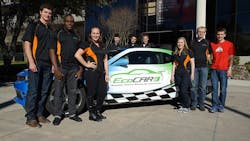EcoCAR 3 Challenges Students, Industry Partners to Improve Hybrid Cars
Students, you have a Chevy Malibu and three years to improve its efficiency and emission levels without compromising performance or safety. Focus on hybrid-electric technology. And… go.
This was the EcoCAR 2 challenge, presented by Argonne National Laboratory and accepted by students at 15 universities. For six consecutive years, Ohio State University’s team has made the top five. This year, the race is on, as the OSU team intends to achieve their seventh victory in the EcoCAR 3 challenge.
Watch a video on the EcoCar 3 challenge, curated by Engineering TV, below:
EcoCAR 3, which started August 1, 2014 and terminates in 2018, is sponsored by General Motors and the U.S. Department of Energy. The new challenge features the most technologically advanced Camaro and tasks the team with creating an energy-efficient powertrain to maximize performance. Students’ focus is on choosing alternate fuels and advanced technologies to lower greenhouse gases and tailpipe emissions. The design must keep the original body design, and preserve safety and consumer standards. Teams are given technical specifications, such as a 0-60 mph acceleration time, energy usage, passenger capacity, and vehicle weight.
Over the 19 years that OSU has participated in the EcoCAR challenges, past teams have recorded actions that led to successes in their models. They also remember to warn future teams of previous mistakes, so that things can be done differently the next year.
Recalling his work in EcoCAR 2, M.J. Yatsko, graduate student and co-engineering manager of the EcoCAR 3, highlights the importance of refining the front-end design process to avoid problems while building the final prototype. “If you don't design the best one possible, it won’t be the best one possible.”
The team also refined their original eco-friendly theme, in order to ensure acceptance into the competition (only 16 schools out of 300 applicants were accepted to participate). Along with making a low-emission car, the team stressed their goals of making the transformed Camaro meet monetary, speed, and acceleration standards set by the average driver.
Leaning from the EcoCAR 2
Ohio State University’s EcoCAR 2 team consisted of 15 graduate students and 30 undergraduates, all from a wide range of majors, including mechanical engineering, electrical engineering, business, and communications.
Meet the Ohio State team, curated by Engineering TV, below:
Fueled with E85 ethanol and powered with parallel-series plug-in hybrid electrical vehicle architecture, the Chevy Malibu was repurposed with a Global Vehicle Motor (GVM) series traction motor from Parker Hannifin. It helped reduce emissions by half and improved fuel economy.
The GVM line features lightweight motors with high-power outputs and low power consumption. The Chevy’s new motor demonstrated 50 mpg performance while using only 315 Watt-hours per mile of electricity.
For the EcoCAR 3, OSU plans to use another model in Parker Hannifin’s GVM line. Since the OSU team requested Parker Hannifin’s GVM before the prototype was finished, Parker engineers were able to incorporate features to meet the criteria generated by the team and in the challenge rules.
Collaboration between the two teams provided a learning opportunity for both parties: “That was something we didn’t have with previous motor suppliers,” says Yatsko. “Parker developed prototype motors for us, and although it was just going into production with their motors for automotive purposes, we needed them before they would be in that production phase. So they worked with us to design motors with the specifications we needed. Not only did we get motors specifically designed for us, but we went up to their test facility and did motor dynamometer testing so we could do validation and make sure the motors would work for us.”
The Chevy Malibu and Camaro are different, one a high-performance sports car and the other a mid-sized sedan. However, motors in the GVM line are easily fitted to different cars, so the OSU team is going to use the same line again for EcoCAR 3. The new motor will use different diameters, lengths, and windings to fit into the new car and suit the new powertrain. “Any feedback we get from this competition will go into the next revision of our GVM,” says Jay Schultz, Parker's Traction Motor Product Manager.
Combining the expertise of automotive engineers and the fresh, open minds of students produces innumerable opportunities for innovation and creative design. From the competition criteria and team goals, engineers learn what consumers and automotive industries are looking for in the future of clean-air automobiles. With the continuance of EcoCAR competitions, the automotive industry hopes to spur innovation to produce smart, hybrid, and alternative-energy cars.
About the Author
Leah Scully
Associate Content Producer
Leah Scully is a graduate of The College of New Jersey. She has a BS degree in Biomedical Engineering with a mechanical specialization. Leah is responsible for Machine Design’s news items that cover industry trends, research, and applied science and engineering, along with product galleries. Visit her on Facebook, or view her profile on LinkedIn.

